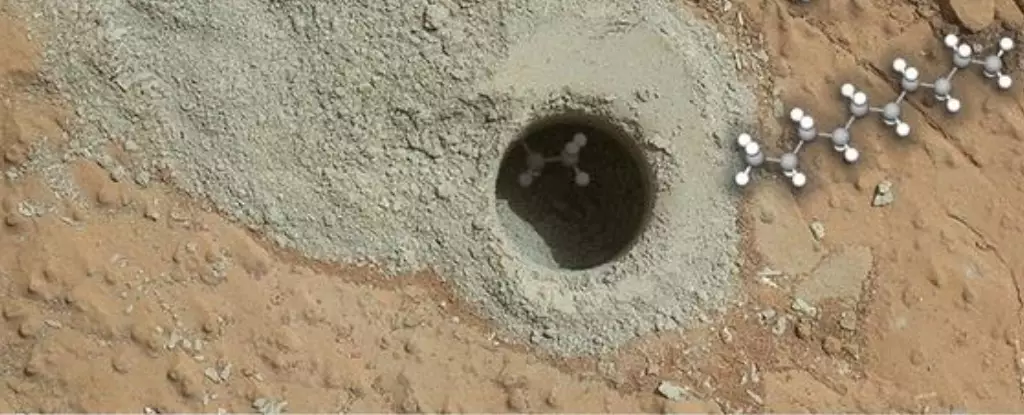The surface of Mars has long fascinated scientists and enthusiasts alike, not only for its stark beauty but also for the tantalizing prospects of past life. Recent findings hint at a deeper story locked away in the Martian soil — the detection of carbon chains that may have originated in what was once an ancient lakebed. Researchers from an international team led by Caroline Freissinet from the French National Centre for Scientific Research (CNRS) have meticulously analyzed these carbon compounds, revealing exciting possibilities for understanding the history of life on the red planet.
Using its robust sampling instruments, NASA’s Curiosity rover has once again proven itself to be a powerful tool in the ongoing quest for extraterrestrial life. The discovery of saturated hydrocarbon chains consisting of up to a dozen carbon atoms adds a significant chapter to our understanding of organic chemistry on Mars. However, as with all scientific endeavors, this new data brings with it a multitude of questions, pushing researchers to dig deeper.
Compounds from the Past: A Double-Edged Sword
These long carbon chains, identified through a gas chromatography-mass spectrometry procedure, offer a double-edged sword of potential scientific significance. While some of these compounds may have formed through non-biological processes, their mere presence indicates the complexity of Mars’ ancient environments. “The provenance and distribution of these molecules are of high interest in the search for potential biosignatures on Mars,” the researchers observed. The more we learn about the geological and chemical landscapes of Mars, the more it shapes our hypotheses regarding past life.
Curiosity’s journey through the Gale crater has unveiled numerous fascinating deposits, from chlorinated compounds to nitrates, which makes the spectral landscape of Mars more complex and intriguing. The implications of these findings may not only reshape our understanding of the planet’s history but also fuel our curiosity about the possibility of life existing—or having existed—far away from Earth.
Behind the Methodology: A Glimpse into Mars’ Chemistry
The methodologies behind this discovery are noteworthy in themselves. An experimental procedure was employed where a chemical enhancer helped analyze mineral samples from a mudstone deposit known as Cumberland. Elevated temperatures near 850 °C (1,562 °F) were carefully controlled to minimize combustion, allowing researchers to gain insights into the mineral makeup of Martian soil. Among the significant revelations were hydrocarbon chains like decane (C10H22), undecane (C11H24), and dodecane (C12H26), which, though found in minuscule concentrations, represent some of the largest carbon structures observed on Mars to date.
Moreover, researchers explored how Mars-like mineral conditions could potentially allow simpler organic compounds to evolve into these carbon chains. This approach does not dismiss the notion of abiotic processes entirely; rather, it opens a dialogue about the chemical pathways that might have once existed in a more favorable Martian climate.
Flirting with the Concept of Life: What Do These Findings Mean?
Despite the potential for these compounds to have emerged from lifeless processes, it is incredibly tempting to entertain the notion of a Martian biochemistry akin to that which flourishes on Earth. The presence of carboxylic acids in our own biological systems offers tantalizing parallels. While abiotic mechanisms can create these compounds, their widespread occurrence is also suggestive of biological processes on our own planet. Thus, the implications of these Martian findings extend beyond mere curiosity; they touch on existential questions that humanity has pondered for centuries.
The continuing revelation of organic molecules on Mars not only reshapes our scientific frameworks but also propels imagination and speculation. Are we truly alone in the universe? Could these long chains of carbon serve as ephemeral remnants of entirety?
Looking Ahead: The Road to Future Discoveries
Amidst the excitement of these discoveries, it is crucial to remember that our current technology has merely scratched the surface of what lies beneath. The search for life, or evidence of life, on Mars will require future missions strategically designed to probe deeper and explore vital areas that may hold more concrete evidence. While we are far from definitive answers, each exploration lays the groundwork for the next, leading us closer to unveiling with clarity what has shaped Mars’ chemical landscape over millions of years.
The importance of curiosity-driven research cannot be overstated. In this era of advanced exploration technology, our aspirations for uncovering the mysteries of Mars and its geological history continue to fuel not only academic inquiry but also the dreams of future generations.


Leave a Reply